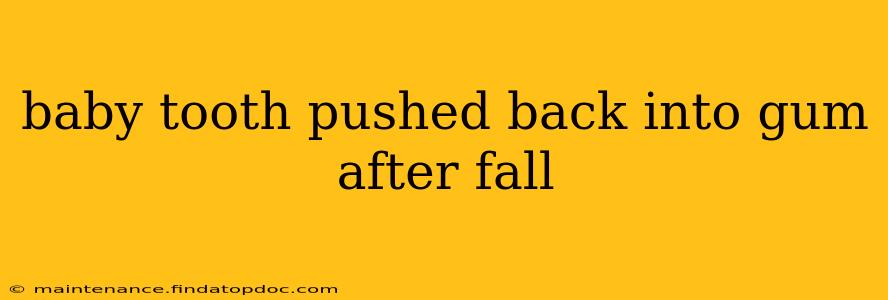A fall resulting in a baby tooth being pushed back into the gum is a frightening experience for both parents and children. Knowing how to react quickly and effectively can make a significant difference in the outcome. This guide explains what to do if your child experiences this type of dental injury and addresses common concerns.
What Should I Do if My Child's Baby Tooth is Pushed Back into the Gum?
The first step is to remain calm. A panicked response will only increase your child's anxiety. Gently clean the area around the mouth with a clean cloth or gauze. Do not attempt to reposition the tooth yourself. This can cause further damage to the surrounding tissues and potentially increase the risk of infection.
Next, contact your dentist or pediatric dentist immediately. They are best equipped to assess the situation and determine the appropriate course of action. Time is of the essence, especially with young children.
Is it an Emergency?
Yes, this situation is considered a dental emergency. While baby teeth are eventually replaced, the underlying developing permanent tooth can be damaged if the injury is not properly addressed. Infection is also a significant concern. Prompt professional care is crucial to minimize long-term complications.
What Happens During a Dental Visit After a Baby Tooth is Replanted?
Your dentist will likely perform a thorough examination of your child's mouth. This will involve checking the injured tooth, the surrounding gums, and the developing permanent tooth. They may take X-rays to assess the extent of the injury and rule out any damage to the underlying permanent tooth. Depending on the severity, treatment might involve:
- Observation: In some cases, the tooth might re-erupt naturally. Your dentist will monitor its progress and advise on appropriate home care.
- Minor repositioning: In certain instances, the dentist may be able to gently reposition the tooth.
- Extraction: If the tooth is severely damaged or causing infection, it may need to be extracted.
My Child's Tooth is Loose But Not Pushed Back – Is That Still a Problem?
Even if the baby tooth is loose but not completely pushed back into the gum, it warrants a visit to the dentist. Loose teeth can be a sign of injury that might affect the developing permanent tooth. Your dentist can assess the extent of damage and provide guidance on proper care.
Will this Affect the Permanent Tooth?
This is a common concern. The extent of the damage to the permanent tooth depends on the severity of the injury. Early intervention greatly reduces the risk of complications to the developing permanent tooth. Prompt dental treatment is essential to mitigate any potential long-term effects.
What Kind of Aftercare is Needed?
After a visit to the dentist, follow their specific instructions carefully. This may include:
- Gentle cleaning: Carefully clean the area around the injured tooth to prevent infection.
- Pain management: Your dentist may recommend over-the-counter pain relievers or other pain management strategies.
- Monitoring: Regular follow-up appointments may be necessary to monitor the healing process.
How Can I Prevent Similar Incidents in the Future?
Preventing falls and injuries is crucial. Consider the following preventative measures:
- Childproofing: Make your home safe for your child by removing tripping hazards, securing furniture, and using appropriate safety gates.
- Supervision: Always supervise children, especially in areas where falls are possible.
- Protective Gear: Encourage the use of helmets and other safety gear during activities that carry a risk of falls.
Remember, prompt attention to a baby tooth pushed back into the gum is essential. Don't hesitate to contact your dentist immediately. Their expertise and swift action can help prevent more significant problems and ensure the health of your child's developing smile.
